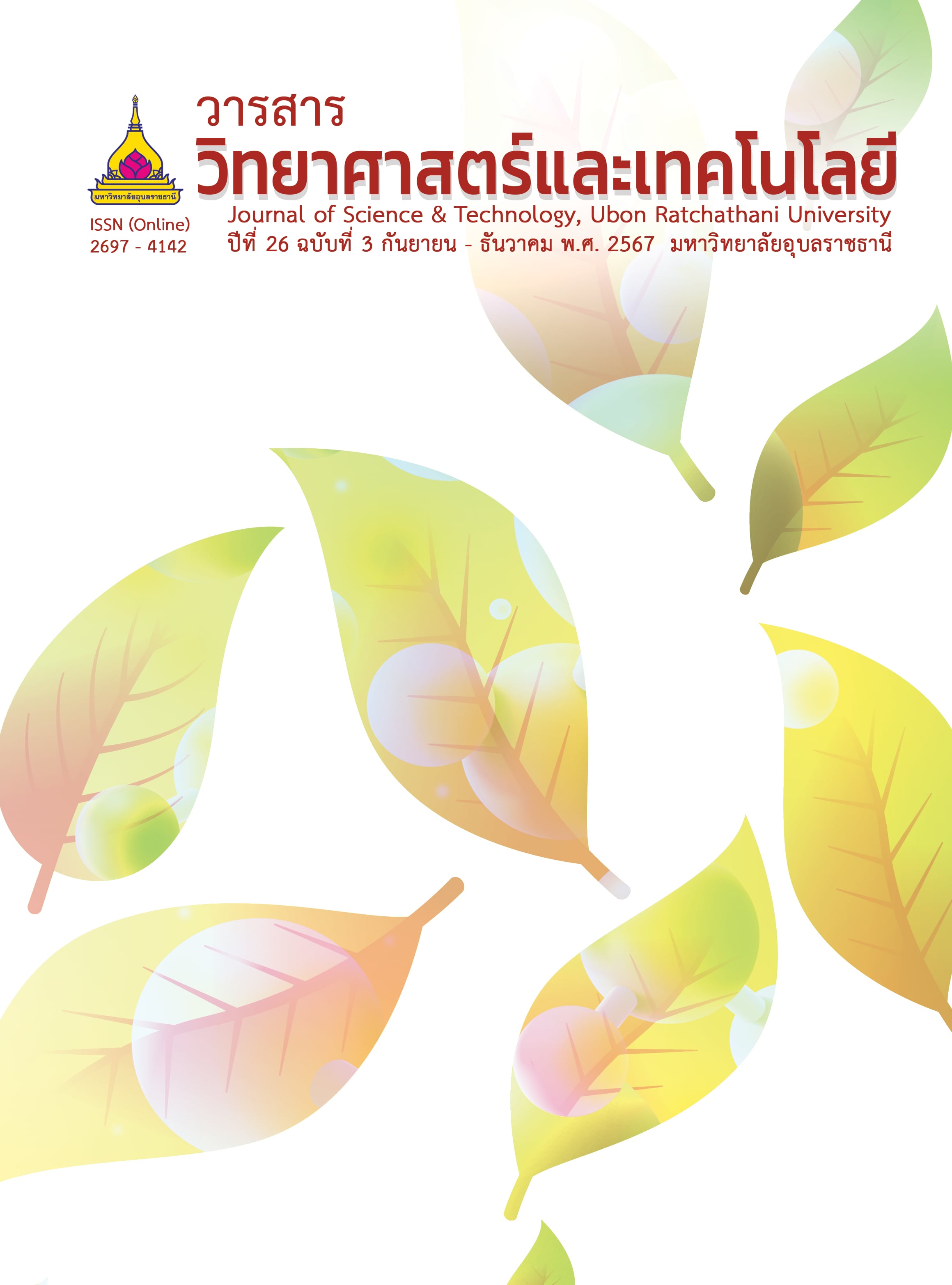ประสิทธิภาพของเชื้อราเอนโดไฟต์ Neosartorya fischeri UB-SD-B4 ในการยับยั้งการเจริญของ เชื้อรา Fusarium oxysporum f. sp. lycopersici ที่เป็นสาเหตุของโรคเหี่ยวในมะเขือเทศ
Main Article Content
บทคัดย่อ
งานวิจัยนี้มีวัตถุประสงค์เพื่อศึกษาประสิทธิภาพของเชื้อราเอนโดไฟต์ Neosartorya fischeri UB-SD-B4 ในการยับยั้งการเจริญของเชื้อรา Fusarium oxysporum f. sp. lycopersici ที่เป็นสาเหตุของโรคเหี่ยวในมะเขือเทศ โดยเชื้อราเอนโดไฟต์ที่ใช้ในการศึกษานี้แยกได้จากกิ่งของต้นทรายเด่น (Polyalthia cerasoides) และถูกระบุชนิดโดยเทคนิคทางอณูชีววิทยา การทดสอบความสามารถของเชื้อราเอนโดไฟต์ในการยับยั้งเชื้อรา F. oxysporum f. sp. lycopersici ในระดับห้องปฏิบัติการใช้วิธี dual culture คุณสมบัติส่งเสริมการเจริญเติบโตของพืชของเชื้อราเอนโดไฟต์ตรวจสอบจากความสามารถในการผลิตกรดอิลโดลอะซิติก และความสามารถในการละลายฟอสเฟต ผลการทดลองแสดงให้เห็นว่าเชื้อราเอนโดไฟต์ N. fischeri UB-SD-B4 สามารถยับยั้งการเจริญทางเส้นใยของเชื้อรา F. oxysporum f. sp. lycopersici ได้ 65.65 เปอร์เซ็นต์ และยังสามารถผลิตกรดอิลโดลอะซิติก และละลายฟอสเฟต ได้เท่ากับ 8.102 และ 3,607 พีพีเอ็ม ตามลำดับ ความสามารถของเชื้อราเอนโดไฟต์ N. fischeri UB-SD-B4 ในการยับยั้ง เชื้อราก่อโรคพืช F. oxysporum f. sp. lycopersici ได้ทำการทดลองกับมะเขือเทศด้วย โดยแบ่งการทดลองออกเป็น 4 ชุดการทดลอง ได้แก่ ชุดการทดลองที่ 1: เมล็ดมะเขือเทศที่ไม่ได้รับเชื้อราใด ๆ ชุดการทดลองที่ 2: เมล็ดมะเขือเทศที่ได้รับเชื้อราเอนโดไฟต์เพียง อย่างเดียว ชุดการทดลองที่ 3: เมล็ดมะเขือเทศที่ได้รับเชื้อราเอนโดไฟต์ร่วมกับเชื้อราก่อโรคพืช และชุดการทดลองที่ 4: เมล็ดมะเขือเทศ ที่ได้รับเชื้อราก่อโรคพืชเพียงอย่างเดียว หลังจากนำเมล็ดมะเขือเทศในทุกชุดการทดลองไปปลูก แล้ววัดความสูงของต้น น้ำหนักสดของลำต้นและราก และน้ำหนักแห้งของลำต้นและราก ผลการทดลองพบว่าเชื้อราเอนโดไฟต์ N. fischeri UB-SD-B4 ทำให้ต้นพืชที่ติดเชื้อราก่อโรค (ชุดการทดลองที่ 3) มีความสูงของต้น น้ำหนักสดของราก และน้ำหนักแห้งของลำต้นและรากเพิ่มขึ้นอย่างมีนัยสำคัญ เมื่อเปรียบเทียบกับต้นพืชที่ติดเชื้อราก่อโรค (ชุดการทดลองที่ 4) งานวิจัยนี้แสดงให้เห็นว่าเชื้อราเอนโดไฟต์ N. fischeri UB-SD-B4 มีศักยภาพที่จะใช้เป็นตัวควบคุมทางชีวภาพของโรคเหี่ยวในมะเขือเทศ และอาจมีบทบาทสำคัญสำหรับการเกษตรแบบยั่งยืน
Article Details

อนุญาตภายใต้เงื่อนไข Creative Commons Attribution-NonCommercial-NoDerivatives 4.0 International License.
บทความที่ได้รับการตีพิมพ์เป็นลิขสิทธิ์ของ วารสารวิทยาศาสตร์และเทคโนโลยี มหาวิทยาลัยอุบลราชธานี
ข้อความที่ปรากฏในบทความแต่ละเรื่องในวารสารวิชาการเล่มนี้เป็นความคิดเห็นส่วนตัวของผู้เขียนแต่ละท่านไม่เกี่ยวข้องกับมหาวิทยาลัยอุบลราชธานี และคณาจารย์ท่านอื่นๆในมหาวิทยาลัยฯ แต่อย่างใด ความรับผิดชอบองค์ประกอบทั้งหมดของบทความแต่ละเรื่องเป็นของผู้เขียนแต่ละท่าน หากมีความผิดพลาดใดๆ ผู้เขียนแต่ละท่านจะรับผิดชอบบทความของตนเองแต่ผู้เดียว
เอกสารอ้างอิง
Hussain, I. and et al. 2016. Study on the biological control of Fusarium wilt of tomato. Journal of Entomology and Zoology Studies. 4(2): 525-528.
Jimenez-Gasco, M.M. and Jimenez-Diaz, R.M. 2003. Development of a specific polymerase chain reaction-based assay for the identification of Fusarium oxysporum f. sp. ciceris and its pathogenic races 0, 1A, 5, and 6. Phytopathology. 93(2): 200-209.
Landa, B.B., Navas-Cortes, J.A. and Jimenez-Diaz, R.M. 2004. Integrated management of Fusarium wilt of chickpea with sowing date, host resistance, biological control. Phytopathology. 94(4): 946-960.
Lee, S. and et al. 2004. Indole-3-acetic acid biosynthesis is deficient in Gluconacetobacter diazotrophicus strains with mutations in Cytochrome c biogenesis genes. Journal of Bacteriology. 186(16): 5384-5391.
Strobel, G. 2003. Endophytes as sources of bioactive products. Microbes and Infection. 5(6): 535-544.
Waller, F. and et al. 2005. The endophytic fungus Piriformospora indica reprograms barley to salt-stress tolerance, disease resistance, and higher yield. The Proceedings of the National Academy of Sciences. 102(38): 13386-13391.
Sarhan, H. and et al. 1999. 5-HT1B receptors modulate release of [3H] dopamine from rat striatal synaptosomes. Naunyn-Schmiedeberg’s Archives of Pharmacology. 359(1): 40-47.
Mmbaga, M.T., Gurung, S. and Maheshwari, A. 2018. Screening of plant endophytes as biological control agents against root rot pathogens of pepper (Capsicum annum L.). Journal of Pathology and Microbiology. 9(3): 1-8.
Yodsing, N. and et al. 2018. Diversity of endophytic fungi isolated from Thai medicinal plants (Casearia grewiifolia) in Khon Kaen, Thailand, and their bioactive compounds. Chiang Mai Journal of Science. 45(1): 45-59.
Hoge, J.H.C. and et al. 1982. Absence of differences in polysomal RNA from vegetative monokaryotic and dikaryotic cells of the fungus Schizophyllum commune. Experimental Mycology. 6(3): 225-232.
White, T.J. and et al. 1990. Amplification and direct sequencing of fungal ribosomal RNA genes for phylogenetics. In: Innis M.A. and et al. (eds.) PCR Protocols: A Guide to Methods and Applications. San Diego: Academic Press.
Riddell, R.W. 1950. Permanent stained mycological preparations obtained by slide culture. Mycologia. 42(2): 265-270.
Akrami, M., Golzary, H. and Ahmadzadeh, M. 2011. Evaluation of different combinations of Trichoderma species for controlling Fusarium rot of lentil. African Journal of Biotechnology. 10(14): 2653-2658.
Eksteen, D. and et al. 2001. Mycelial growth inhibition of plant pathogenic fungi by extracts of South African plant species. Annals of Applied Biology. 139(2): 243-249.
Gordon, S.A. and Weber, R.P. 1951. Colorimetric estimation of indole acetic acid. Plant Physiology. 26(1): 192-195.
Bric, J.M., Bostock, R.M. and Siliverstone, S.E. 1991. Rapid in situ assay for indole acetic acid production by bacteria immobilized on a nitrocellulose membrane. Applied and Environmental Microbiology. 57(2): 535-538.
Khamna, S., Yokota, A. and Lumyong, S. 2009. Actinomycetes isolated from medicinal plant rhizosphere soils: Diversity and screening of antifungal compounds, indole-3-acetic acid and siderophore production. World Journal of Microbiology and Biotechnology. 25: 649-655.
Ames, B.N. 1964. Assay of inorganic phosphate, total phosphate and phosphatases. Methods in Enzymology. 8: 115-118.
Murphy, J. and Riley, H.P. 1962. A modified single solution method for the determination of phosphate in natural waters. Analytica Chimica Acta. 27: 31-36.
Schwyn, B. and Neilands, J.B. 1987. Universal chemical assay for the detection and determination of siderophores. Analytical Biochemistry. 160(1): 46-56.
Dimkpa, C.O. and et al. 2008. Involvement of siderophores in the reduction of metal-induced inhibition of auxin synthesis in Streptomyces spp. Chemosphere. 74(1): 19-25.
Mei, L. and et al. 2019. The effects of Trichoderma on preventing cucumber Fusarium wilt and regulating cucumber physiology. Journal of Integrative Agriculture. 8(3): 607-617.
Samson, R.A. and et al. 2007. Diagnostic tools to identify black aspergilli. Studies in Mycology. 59: 129-145.
Bussarakam, K. 2002. Diseases of Terrestrial Orchids, Endophytic Fungi on Leaves and Roots and Diversity of Rhizosphere Fungi. M.Sc. Thesis, Kasetsart University.
Eamvijarn, A. 2013. Neosartorya species: Diversity, Morphology, Phylogeny, Antagonistic Tests Against Plant Pathogenic Fungi and Secondary Metabolites of N. pseudofischeri. Ph.D. Thesis, Kasetsart University.
Howell, C.R. 2003. Mechanisms employed by Trichoderma species in the biological control of plant diseases: The history and evolution of current concepts. Plant Disease. 87(1): 4-10.
Reino, J.L. and et al. 2008. Secondary metabolites from species of the biocontrol agent Trichoderma. Phytochemistry Reviews. 7: 89-123.
Tsavkelova, E. and et al. 2012. Identification and functional characterization of indole-3-acetamide-mediated IAA biosynthesis in plant-associated Fusarium species. Fungal Genetic and Biology. 49(1): 48-57.
Bandara, W.M., Seneviratne, G. and Kulasooriya, S.A. 2006. Interactions among endophytic bacteria and fungi: Effected and potentials. Journal of Biosciences. 31(5): 645-650.
Sati, S.C. and Prabha, P. 2018. Evaluation of phosphate Solubilization by root endophytic aquatic Hyphomycete Tetracladium setigerum. Symbiosis. 77(24): 141-145.
Segarra, G. and et al. 2010. Trichoderma asperellum strain T34 controls Fusarium wilt disease in tomato plants in soilless culture through competition for iron. Microbial Ecology. 59(1): 141-149.
Vinale, F. and et al. 2008. Trichoderma-plant pathogen interactions. Soil Biology and Biochemistry. 40(1): 1-10.
Tyc, O. and et al. 2017. The ecological role of volatile and soluble secondary metabolites produced by soil bacteria. Trends in Microbiology. 25(4): 280-292.


